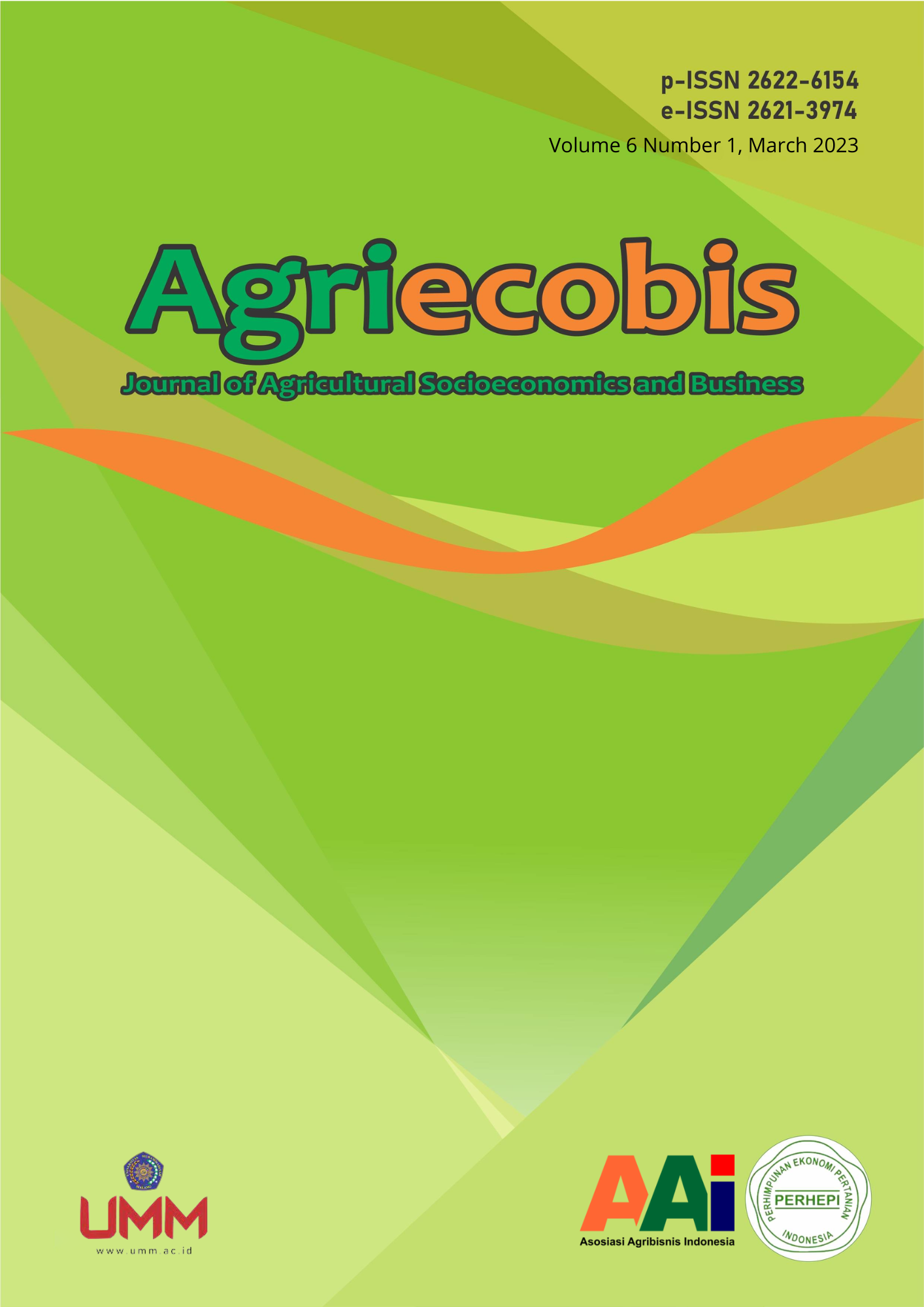Assessing the Viability of Establishing a Dairy Milk Business in the Village Unit Cooperative of Gandusari District, Blitar Regency: A Feasibility Analysis
DOI:
https://doi.org/10.22219/agriecobis.v6i01.24741Keywords:
Business Feasibility, Dairy, Dairy CowAbstract
Milk is a vital animal-derived food product, along with meat and eggs, for human consumption. In Indonesia, the dairy industry is dominated by small and medium-sized dairies. Dairy cows are a significant source of animal protein, and their primary product is milk. In the North of Blitar Regency lies the sub-district of Gandusari, where dairy cow milk is produced in the villages under the coverage of the Village Unit Cooperative called KUD "Semen." This research was initiated to address a problem. Primary and secondary data were collected using a puIDRosive sampling technique, questionnaires, literature review, and observation. The collected data is quantitative, and investment criteria were utilized for analysis. The results of the NPV analysis showed an amount of IDR 18,672,631,280, IRR of 29%, B/C Ratio of 184.04, and PP for eight years and six days, indicating the feasibility of investing in KUD "Semen." Sensitivity analysis was performed based on three assumptions, including the increase in feed costs, operational costs, and decreased milk production of dairy cows. The analysis revealed that the dairy milk business in KUD is sensitive to increased feed prices and decreased production, among the three assumptions.
Downloads
References
Aprillia, S., Prasmatiwi, F. E., & Soelaiman, A. (2021). Analisis Kelayakan Finansial Usaha SapiPerah SentulFresh Indonesia Di Kabupaten Bogor. Jurnal Ilmu-Ilmu Agribisnis, 9, 569-575.
Asperinche, S., Widyasworo, A., & Opi Nita, A. (2020). Analisis Kelayakan Usaha Sapi Perah (Studi Lapang di Peternakan Bapak Khoiri Desa Gledug Kecamatan Sanan Kulon Kabupaten Blitar. AVES: Jurnal Ilmu Peternakan, 12, 52-62.
D, A., A, S., & T, E. (2015). Analisis Pendapatan Peternak Sapi Perah Kecamatan Banyumanik, Kecamatan Getasan, Dan Kecamatan Cepogo. Jurnal Mediagro, 11, 22-33.
Khafsah, Warsito, S. H., Prastya, R. A., Sardjito, T., Saputro, A. L., & Agustono, B. (2018, Oktober). Analisis Kelayakan Usaha Secara Finansial dan Efisiensi Produksi di Peternakan Sapi Perah PT. Fructi Agri Sejati Kabupaten Jombang. Jurnal Medik Veteriner, 1, 113-119.
Poetri, N. A., Basith, A., & Wijaya, N. H. (2014, Agustus). Analisis Kelayakan Pengembangan Usaha Peternakan Sapi Perah KUNAK. Jurnal Manajemen dan Organisasi, V, 123-135.
Rahayu, E. (2013, September). Analisis Pendapatan Usaha Ternak Sapi Perah Di Kecamatan Cepogo Kabupaten Boyolali. Jurnal Sains Peternakan, 11, 99-105.
Anindyasari, D., Setiadi, A., & Ekowati, T. (2015). Analisis pendapatan peternak sapi perah Kecamatan Banyumanik. Jurnal Ilmu-Ilmu Pertanian, 11(2), 22–33.
Aprilia, S., Prasmatiwi, F. E., & Sulaiman, A. (2021). Analisis Kelayakan Finansial Usaha Sapi Perah Sentulfresh Indonesia Di Kabupaten Bogor. Jurnal Ilmu-Ilmu Agribisnis, 9(4), 569. https://doi.org/10.23960/jiia.v9i4.5390
Chandra, A. C., Bakar, A., & Kurniawan, D. (2016). Analisis Kelayakan Usaha Pengolahan Susu Sapi di Kota Wisata Batu Malang. Jurnal Teknik Industri Itenas, 4(02), 219–230.
Christi, R. F., Tasripin, D. S., Suharwanto, D., & Wulandari, E. (2020). Perbandingan Susu Sapi Perah Pada Pemerahan Pagi dan Sore Terhadap Total Plate Count dan Colioform di KUD Gemah Ripah Sukabumi Jawa Barat. Jurnal Ilmu Dan Teknologi Peternakan Tropis, 7(1), 65. https://doi.org/10.33772/jitro.v7i1.8989
Dewi, T. G., & Farmayanti, N. (2011). Analisis kelayakan pengembangan usaha ternak kambing perah (kasus: Peternakan Prima Fit, Kecamatan Ciampea, Kabupaten Bogor). Forum Agribisnis, 1(1), 95–111.
Duwi, D., Sukmawati, S., Sutiarso, E., & Prawitasari, S. (n.d.). Financial And Sensitivity Analysis of The Dairy Cattle Business Based on Business Scale At. 3.
Kartikasari, C. A. (2015). Analisis Kelayakan Finansial dan Strategi Pengembangan Peternakan Sapi Perah pada Koperasi Mahesa di Kabupaten Jember. Digital Repository Universitas Jember, 223.
Khafsah, Warsito, S. H., Prastiya, R. A., Sardjito, T., Saputro, A. L., & Agustono, B. (2018). Analisis Kelayakan Usaha Secara Finansial dan Efisiensi Produksi di Peternakan Sapi Perah PT. Fructi Agri Sejati Kabupaten Jombang (Analysis of Financial Business Feasibility and Production Efficiency in Dairy Cow Livestock PT. Fructi Agri Sejati Jombang. Jurnal Medik Veteriner, 1(3), 113–119. https://e-journal.unair.ac.id/JMV
Poetri, N. A., Basith, A., & Wijaya, N. H. (2016). Analisis Kelayakan Pengembangan Usaha Peternakan Sapi Perah KUNAK (Studi Kasus Usaha Ternak Kavling 176, Desa Pamijahan Kab. Bogor). Jurnal Manajemen Dan Organisasi, 5(2), 122. https://doi.org/10.29244/jmo.v5i2.12147
Rahayu, E. T. (2017). Analisis Pendapatan Usaha Ternak Sapi Perah di Kecamatan Cepogo Kabupaten Boyolali. Sains Peternakan, 11(2), 99. https://doi.org/10.20961/sainspet.v11i2.4852
Zain, W. N. (2013). Kualitas susu kambing segar di Peternakan Umban Sari dan Alam Raya Kota Pekanbaru. Jurnal Peternakan, 10(1), 24–30.
Downloads
Published
How to Cite
Issue
Section
License
Copyright (c) 2023 Agriecobis : Journal of Agricultural Socioeconomics and Business

This work is licensed under a Creative Commons Attribution-ShareAlike 4.0 International License.
Authors who publish with Agriecobis : Journal of Agricultural Socioeconomics and Business agree to the following terms:
- For all articles published in Agriecobis : Journal of Agricultural Socioeconomics and Business, copyright is retained by the authors. Authors give permission to the publisher to announce the work with conditions. When the manuscript is accepted for publication, the authors agree to automatic transfer of the publishing right to the publisher.
- Authors retain copyright and grant the journal right of first publication with the work simultaneously licensed under a Creative Commons Attribution-ShareAlike 4.0 International License that allows others to share the work with an acknowledgment of the work's authorship and initial publication in this journal.
- Authors are able to enter into separate, additional contractual arrangements for the non-exclusive distribution of the journal's published version of the work (e.g., post it to an institutional repository or publish it in a book), with an acknowledgment of its initial publication in this journal.
- Authors are permitted and encouraged to post their work online (e.g., in institutional repositories or on their website) prior to and during the submission process, as it can lead to productive exchanges, as well as earlier and greater citation of published wor (See The Effect of Open Access).

This work is licensed under a Creative Commons Attribution-ShareAlike 4.0 International License.







